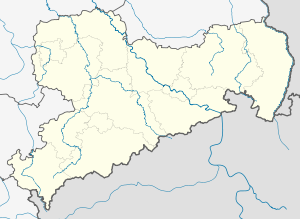Training nuclear reactor Dresden
| Training nuclear reactor Dresden | ||
|---|---|---|
|
|
||
| Coordinates | 51 ° 1 '43 " N , 13 ° 43' 37" E | |
| country | Germany | |
| Data | ||
| operator | TU Dresden | |
| start of building | 1975 | |
| Installation |
AKR-1 : July 28, 1978 AKR-2 : March 22, 2005 |
|
| Shutdown |
AKR-1 : early 2004 AKR-2 : not yet planned |
|
| Reactor type | homogeneous solids-moderated zero-power reactor | |
| Thermal performance | 2 watts | |
| Neutron flux density | 5 × 10 7 n / (cm 2 s) | |
| Website | AKR-2 at the TU Dresden | |
| was standing | June 29, 2011 | |
The Dresden Training Nuclear Reactor ( AKR-2 ) is a teaching and research reactor that has been operated at the Technical University of Dresden since 2005 . The reactor with an output of two watts is mainly used for training and teaching purposes, but it is also used in research projects. The reactor facility is the last nuclear facility in Germany to have received an operating license.
history
In 1975 the conception of the previous model AKR-1 was started at the Technical University of Dresden. It was a homogeneous thermal zero power reactor with a maximum power of two watts. The reactor was developed and built based on the technical concept of the Siemens teaching reactor SUR-100. It was put into operation in July 1978 and used in research and teaching.
Due to the transitional regulation for nuclear facilities of the former GDR in the unification agreement , the training reactor would have lost its operating license on June 30, 2005. The Saxon State Ministry for Science and Art has therefore set up an expert working group to check the continued operation of the reactor plant. On January 8, 1998, the then Minister of State Hans Joachim Meyer gave the go-ahead for continued operation of the training reactor for an unlimited period based on the report of the working group. The TU Dresden then submitted an application for a permit for a new training nuclear reactor AKR-2 to the Saxon State Ministry for Environment and Agriculture on September 15, 1998 . After several years of testing, the operating license for the new plant was finally granted on March 22, 2004.
The old AKR-1 nuclear reactor was then switched off, dismantled and all radioactive substances removed. The construction of the new AKR-2 nuclear reactor took place from April to December 2004. The start and the first criticality of the new reactor took place on March 22, 2005. Teaching began in the 2005 summer semester. The cost of the conversion amounted to 3 million euros.
Carsten Lange is the head of AKR-2.
construction
The AKR-2 training nuclear reactor is a thermal, homogeneous, solids- moderated zero - power reactor . This means that nuclear fission occurs primarily through thermal neutrons , that the nuclear fuel and the moderator are homogeneously distributed in the fuel elements. As with the SUR-100, solid polyethylene (and not, for example, water) is used as a moderator . Due to the low power of two watts, there is practically no fuel consumption and no radioactive waste generation or activation of the construction materials.
The reactor has a cylindrical shape with a height of 3.5 meters, a diameter of 2.5 meters and a total mass of 30 tons. The also cylindrical gap zone in the reactor core is made up of plate-shaped fuel elements and, for safety reasons, divided into two separable, hermetically sealed sections. The fuel elements have a diameter of 250 mm and a plate thickness between 2 mm and 23 mm. The biological shielding consists of a 48 cm thick layer of barite concrete in the axial direction and a 12 cm thick paraffin layer followed by 63 cm of barite concrete in the radial direction . The reactor lid is removable.
19.8 percent enriched uranium is used as nuclear fuel . The critical mass is around 790 grams. The nuclear chain reaction can be controlled by three absorber rods made of cadmium , which can be moved vertically in the reactor. The reactor condition is monitored by three neutron measuring channels. For focusing the neutrons are graphite - reflectors used. There are four horizontal and two vertical experiment channels for test measurements. The undisturbed neutron flux is 5 · 10 7 cm −2 · s −1 .
The reactor is designed in such a way that a prompt, supercritical state cannot be brought about under any circumstances by incorrect operation. A reactor shutdown is automatically initiated when the relevant criteria are addressed, but it can also be triggered manually from the control panel. The control rods are retracted and the two core halves are separated at the same time. Both shutdown processes are driven exclusively by gravity and do not require any external energy supply.
Course offer
At the training nuclear reactor , internships will be on the subject areas
- Reactor operation : reactor start, control rod calibration, critical experiment, neutron flux measurement, etc. and
- Radiation protection : construction of counter tubes, determination of half-lives, gamma spectroscopy, shielding, etc.
offered. The reactor can be visited on certain dates by appointment.
See also
Web links
- Homepage of the training nuclear reactor Dresden at the Technical University of Dresden
- Information sheet on the training nuclear reactor Dresden (PDF file; 506 kB)
swell
- ↑ Brochure on the construction and commissioning of the Dresden training nuclear reactor (PDF; 646 kB), Dresden University of Technology
- ^ Carsten Lange , professorship for hydrogen and nuclear energy technology, TU Dresden
- ↑ Structure of the training nuclear reactor in Dresden (PDF; 186 kB), Technical University of Dresden


